Kitty Marion

Kitty Marion (Katherina Schafer) was born in Westphalia, Germany on 12th March 1871. Her mother died when she was two and her stepmother when she was six, both of tuberculosis. Her childhood was spent moving between her father, "a strict disciplinarian with a fierce, violent, and evidently uncontrollable temper". (1)
In 1886 she moved to England to be with her sister, Dora. After learning English she adopted the name Kitty Marion and became an actress. In 1889 she was engaged for the pantomime season in Glasgow. According to her biographer, Vivien Gardner: "Her first job was as a chorus member in Robinson Crusoe at the Theatre Royal, Glasgow. Between 1889 and 1903, adopting the name Kitty Marion, she developed a modest but successful career in provincial touring theatre as a singer and dancer in musical comedy and pantomime, graduating from the chorus to minor named roles." (2)
Over the next few years she became a star of the musical hall and she was billed as the "Refined Vocal Comedienne". In 1899 she appeared at the Prince of Wales Theatre in Liverpool, on the same bill as Vesta Tilley. (3) In her autobiography she complained about the "casting couch" tactics of music-hall agents and this was one of the factors that encouraged her to join the Women's Social and Political Union (WSPU) in 1908. "For Marion, it was a radical ideology that answered the aggressive and violent assaults she had been subjected to throughout her working life, and offered a clear way to combat the social attitudes that dominated her world - the misogynistic belief that any man had a physical right to any woman's body, without her consent." (4)
Kitty Marion joins WSPU
Kitty Marion took a keen interest in politics and in 1908 joined the Women's Social and Political Union (WSPU). She moved to Hartfield in East Sussex and was an active member of the WSPU branch in Brighton. In June she was arrested during a demonstration outside the House of Commons. She later recalled: "Two policemen, one on each arm, quite unnecessarily pinching and bruising the soft underarm, with the third often pushing at the back, would run us along and fling us, causing most women to be thrown to the ground." (5)
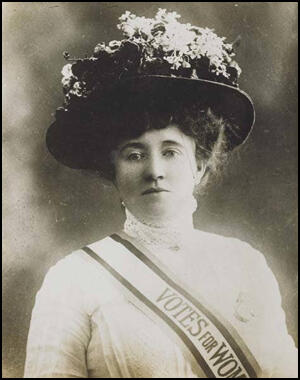
Kitty Marion was a supporter of direct action and in July 1909 she was arrested and found guilty of throwing stones at a post office in Newcastle. She was sentenced to a month's imprisonment, went on hunger strike, and was forcibly fed. (6) She barricaded herself in her cell and set fire to her mattress as a protest at her treatment at the hands of the doctors who she described as the "dirty, cringing doormats of the government". (7)
Actresses' Franchise League
Later that year Kitty Marion joined Elizabeth Robins in helping to form the Actresses' Franchise League. The AFL was open to anyone involved in the theatrical profession and its aim was to work for women's enfranchisement by educational methods, selling suffrage literature and staging propaganda plays. Other actresses who joined included Winifred Mayo, Sime Seruya, Edith Craig, Inez Bensusan, Ellen Terry, Lillah McCarthy, Sybil Thorndike, Vera Holme, Lena Ashwell, Christabel Marshall, Lily Langtry and Nina Boucicault. (8)
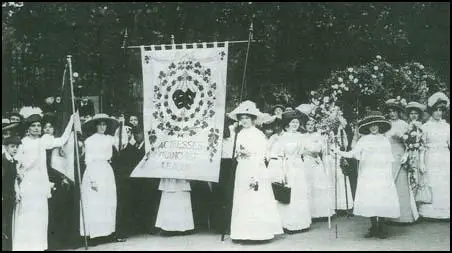
In October 1909 she joined forces with Constance Lytton, Jane Brailsford and Emmeline Pethick-Lawrence and wrote a letter to The Times saying: "We want to make it known that we shall carry on our protest in our prison cells. We shall put before the Government by means of the hunger-strike four alternatives: to release us in a few days; to inflict violence upon our bodies; to add death to the champions of our cause by leaving us to starve; or, and this is the best and only wise alternative, to give women the vote." (9)
Kitty Marion continued to work as an actress and was a significant figure in the Variety Artists' Federation and its campaign against of theatrical agents who she claimed were sometimes involved in the "white slave trade". As Elizabeth Crawford, the author of The Women's Suffragette Movement: A Reference Guide (1999), pointed out: "She received a WSPU hunger strike medal in a ceremony at the Albert Hall on 9 December and then went on to do the Christmas pantomime season." (10)
During the 1910 General Election the NUWSS organised the signing petitions in 290 constituencies. They managed to obtain 280,000 signatures and this was presented to the House of Commons in March 1910. With the support of 36 MPs a new suffrage bill was discussed in Parliament. The WSPU suspended all militant activities and on 23rd July they joined forces with the NUWSS to hold a grand rally in London. When the House of Commons refused to pass the new suffrage bill, the WSPU broke its truce on what became known as Black Friday on 18th November, 1910, when its members clashed with the police in Parliament Square. Kitty Marion was arrested during this demonstration but she was released without charge. (11)
Kitty Marion toured the country giving lectures and musical performances. She was billed as the "Music Hall Artiste and Militant Suffragette" and after one meeting in Colchester it was reported: "The awe experienced by the audience was quickly succeeded by delight, for the lady proved a charming vocalist".
Hunger Strikes
In November 1911 she was again arrested outside the House of Commons after taking part in the protest following the defeat of the Conciliation Bill, and was sentenced to 21 days' imprisonment. When in Holloway Prison she again went on hunger-strike and was forced-fed. A friend, Mary Leigh, described what it was like to experience this form of punishment: "On Saturday afternoon the wardress forced me onto the bed and two doctors came in. While I was held down a nasal tube was inserted. It is two yards long, with a funnel at the end; there is a glass junction in the middle to see if the liquid is passing. The end is put up the right and left nostril on alternative days. The sensation is most painful - the drums of the ears seem to be bursting and there is a horrible pain in the throat and the breast. The tube is pushed down 20 inches. I am on the bed pinned down by wardresses, one doctor holds the funnel end, and the other doctor forces the other end up the nostrils. The one holding the funnel end pours the liquid down - about a pint of milk... egg and milk is sometimes used." (12)
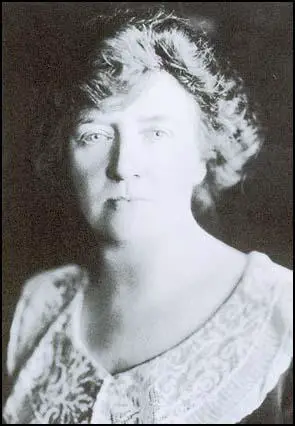
Christabel Pankhurst decided that the WSPU needed to intensify its window-breaking campaign. On 1st March, 1912, a group of suffragettes volunteered to take action in the West End of London. The Daily Graphic reported the following day: "The West End of London last night was the scene of an unexampled outrage on the part of militant suffragists.... Bands of women paraded Regent Street, Piccadilly, the Strand, Oxford Street and Bond Street, smashing windows with stones and hammers." (13)
Kitty Marion recalls in her autobiography that she broke windows of the Silversmiths' Association and at Sainsbury's at 134 Regent Street. She was arrested, found guilty and sentenced to six month's imprisonment. Holloway Prison was full so Marion and 23 other members of the WSPU were sent to Winson Green Prison in Birmingham. She again went on hunger-strike and she was released after 10 days. (14)
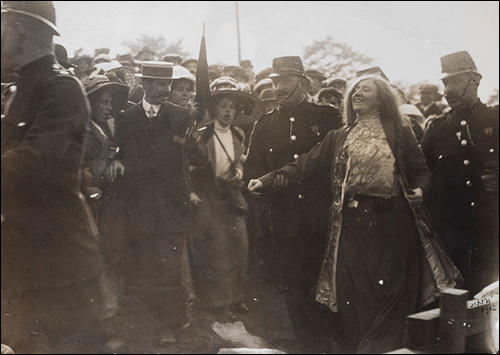
In July 1912, the WSPU began organizing a secret arson campaign. According to Sylvia Pankhurst: "When the policy was fully underway, certain officials of the Union were given, as their main work, the task of advising incendiaries, and arranging for the supply of such inflammable material, house-breaking tools and other matters as they might require. Women, most of them very young, toiled through the night across unfamiliar country, carrying heavy cases of petrol and paraffin. Sometimes they failed, sometimes succeeded in setting fire to an untenanted building - all the better if it were the residence of a notability - or a church, or other place of historic interest." (15)
Young Hot Bloods
The WSPU used a secret group called Young Hot Bloods to carry out these acts. No married women were eligible for membership. The existence of the group remained a closely guarded secret until May 1913, when it was uncovered as a result of a conspiracy trial of eight members of the suffragette leadership, including Flora Drummond, Annie Kenney and Rachel Barrett. (16) During the trial, Barrett said: "When we hear of a bomb being thrown we say 'Thank God for that'. If we have any qualms of conscience, it is not because of things that happen, but because of things that have been left undone." (17)
Kitty Marion decided she would join this group: "I was becoming more and more disgusted with the struggle for existence on commercial terms of sex … I gritted my teeth and determined that somehow I would fight this vile, economic and sex domination over women which had no right to be, and which no man or woman worthy of the term should tolerate." It has been argued that this group included Helen Craggs, Olive Hockin, Lilian Lenton, Miriam Pratt, Norah Smyth, Clara Giveen, Hilda Burkitt, Olive Wharry and Florence Tunks. (18)
Fern Riddell has pointed out: "Kitty Marion's hand is evident in attacks from Manchester to Portsmouth; the scope of her attacks overlays neatly into areas she had become well acquainted with during her music hall and theatrical days, which afforded her the luxury of an already established network of lodging houses and local knowledge, allowing her to visit areas and conduct militant activity." (19)
Clara Giveen teamed up with Kitty Marion. "Clara was ten years younger than Kitty... It is not unusual to find the pairing of a woman in her mid-thirties with a younger, early twenties woman among the militant suffragettes who caused such damage at the time. The bonds between these women, working in pairs, became unbreakable.". (20)
The women decided that setting fire to the Grand Stand at the Hurst Park racecourse as it "would make a most appropriate beacon". The women returned to a house in Kew owned by Eileen Casey. A police constable who had been detailed to watch the house, saw the two women return and during the course of the next morning they were arrested. (21)
Giveen's local newspaper reported: "One of the two Suffragettes arrested at Kingston charged in connection with the fire which on Monday did £10,000 damage to the stands at Hurst Park racetract was Miss Clara Giveen. Miss Giveen who is a lady of independent means, is known in Bexhill, having been associated for some time with the local branch of the WSPU. When arrested at the residence of Dr Casey, Miss Giveen was found lying on a bed in one of the upper rooms, fully dressed. By her side was a copy of the Suffragette. In her room there was a quantity of resin... Miss Giveen in whose room was found the picture of a house burnt down at Eastbourne, was remanded, bail being allowed." (22)
It seems that the police had been watching the homes of women that had been offering help to those women involved in these arson attacks. "On Tuesday two women, Kitty Marion and Clara Giveen, of independent means, were charged at Richmond with loitering, with intent to commit a felony. A policeman who followed them about various streets at Kew at a quarter past 2 on Monday morning, questioned them, and seen them eventually enter the home of a Dr Casey with a latchkey. A tramcar man identified Marion as being with another women near the racecourse shortly before the fire, and there is other identification evidence. A piece of carpet used to get over the barbed wire of Hurst Park is identified by Marion's landlady as her property." (23)
Their trial began at Guildford on 3rd July. Giveen and Marion were defended by Ian Macpherson, a Liberal Party member of Parliament, who did not call any evidence. "He pleaded to the jury for an unbiased judgment, and to guard against a certain type of female who felt she was being defrauded by the law of the land of what she regarded as a just and proper - the exercise of the vote." Giveen said no evidence should be passed as they had not been tried by their peers. "Until women were on a jury as well as men, no sentence should be passed upon women." (24)
The main evidence against the women involved a fireman called Brown who claimed he saw Marion and Giveen carrying a portmanteau (a large travelling bag). Nearly two hours later he heard a fire hooter and discovered the fire. Soon afterwards he encountered the same woman without the portmanteau. "They were also seen by a tramcar driver named Middleton, who identified Miss Marion. Later the police found tracks leading to the fence bounding the racecourse, and a large piece of Brussels carpet. At the grand stand were found copies of The Suffragette, showing somebody interested in the question had visited it. (25)
Cara Giveen and Kitty Marion were found guilty and sentenced to three years' penal servitude. They both went on hunger strike and after five days were released under the Cat & Mouse Act. (26) They were taken to a Women's Social and Political Union nursing home, and placed under the care of Dr. Flora Murray and Catherine Pine. (27)
Christabel Pankhurst pointed out: "Perhaps the Government will realise now that we mean to fight to the bitter end … If men use explosives and bombs for their own purpose they call it war, and the throwing of a bomb that destroys other people is then described as a glorious and heroic deed. Why should a woman not make use of the same weapons as men. It is not only war we have declared. We are fighting for a revolution." (28)
1913 Arson Campaign
In 1913 the WSPU arson campaign escalated and railway stations, cricket pavilions, racecourse stands and golf clubhouses being set on fire. Slogans in favour of women's suffrage were cut and burned into the turf. Suffragettes also cut telephone wires and destroyed letters by pouring chemicals into post boxes. Marion was a leading figure in the WSPU arson campaign and she was responsible for setting fire to Levetleigh House in St Leonards in April 1913. (29)
From a scrapbook she kept it seems that Kitty Marion also set fire to a train, left standing between Hampton Wick and Teddington on 26th April: "The train was afterwards driven into Teddington Station, where an examination resulted in the discovery of inflammable materials in almost every set of coaches. Among the articles found in the train were partly-burnt candles, four cans of petroleum, three of which had been emptied of their contents, a lady's dressing case containing a quantity of cotton wool, and packages of literature dealing with the woman suffrage movement. Newspaper cuttings of recent suffragette outrages were also found scattered about the train … The method adopted was very simple. First the cushions were saturated with petroleum, and then small pieces of candle were lighted immediately under the seats." (30)
As soon as she recovered she went out and broke a window of the Home Office. She was arrested and taken back to Holloway Prison. After going on hunger strike for five days she was again released to a WSPU nursing home. According to her own account, she now set fire to various houses in Liverpool (August, 1913) and Manchester (November, 1913). These incidents resulted in a series of further terms of imprisonment during which force-feeding occurred. It has been calculated that Kitty Marion endured 232 force-feedings in prison while on hunger strike.
Elizabeth Robins disapproved of Kitty Marion's arson campaign but she wrote a circular letter to over 100 leading figures asking them to bring an end to these force-feedings. (31) Robins and Octavia Wilberforce used their 15th century farmhouse at Backsettown, near Henfield, as a hospital and helped her recover from her various spells in prison and the physical effects of going on hunger strike. On 31st May 1914, with the help of Mary Leigh, she escaped to Paris. (32)
First World War
The British government declared war on Germany on 4th August 1914. Two days later, Millicent Fawcett, the leader of the NUWSS declared that the organization was suspending all political activity until the conflict was over. Fawcett supported the war effort but she refused to become involved in persuading young men to join the armed forces. The WSPU took a different view to the war. It was a spent force with very few active members. According to Martin Pugh, the WSPU were aware "that their campaign had been no more successful in winning the vote than that of the non-militants whom they so freely derided". (33)
The WSPU carried out secret negotiations with the government and on the 10th August the government announced it was releasing all suffragettes from prison. In return, the WSPU agreed to end their militant activities and help the war effort. Christabel Pankhurst, arrived back in England after living in exile in Paris. She told the press: "I feel that my duty lies in England now, and I have come back. The British citizenship for which we suffragettes have been fighting is now in jeopardy." (34)
After receiving a £2,000 grant from the government, the WSPU organised a demonstration in London. Members carried banners with slogans such as "We Demand the Right to Serve", "For Men Must Fight and Women Must Work" and "Let None Be Kaiser's Cat's Paws". At the meeting, attended by 30,000 people, Emmeline Pankhurst called on trade unions to let women work in those industries traditionally dominated by men. She told the audience: "What would be the good of a vote without a country to vote in!". (35)
Kitty Marion was one of those members of the Women's Social and Political Union who disagreed with the policy of ending militant activities. She resumed her career as an actress but continued to campaign for the vote. As she had been born in Germany, the government decided to deport her from Britain. After protests from figures such as Constance Lytton and Emmeline Pethick-Lawrence, she was allowed to go to the United States. (36)
Birth Control Campaign
In America she immediately became involved in politics and worked with Margaret Sanger, Lou Rogers and Cornelia Barns in publishing the Birth Control Review. She was arrested several times for violating obscenity laws in New York, and was imprisoned for 30 days in 1918. While in prison Kitty Marion met two other radicals, Mollie Steimer and Agnes Smedley. In 1921 Marion joined Sanger in establishing America's first birth-control clinic. However, the clinic in Brooklyn was closed by the police. (37)
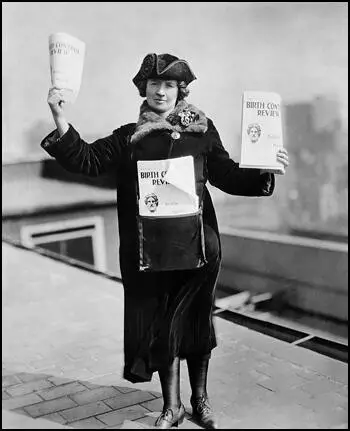
Kitty Marion, wrote an autobiography about her experiences but it was never published. In 1930 she moved to London and gave a copy to the Fawcett Library. She worked with Edith How-Martyn at the Birth Control International Centre. but later returned to New York City and lived there until her death at the Sanger Nursing Home on 9th October 1944. (38)
Primary Sources
(1) Laura Ruttum, Kitty Marion (2005)
Kitty Marion, actress, suffragist agitator and birth control advocate, was born Katherina Schafer in Germany in 1871. Fleeing the authority of her strict father, at the age of fifteen Marion emigrated to England. She soon pursued the career of a traveling actress, during which time she took the stage name she was to use for the remainder of her life. Her disgust at the exploitation of female actresses, paired with her observations of the realities of women's lives around the country, kindled the beginnings of Miss Marion's career as an activist - a career that began with her denunciations of the theater industry, but soon shifted to active participation in the British Suffragette movement.
Miss Marion joined the Pankhursts' Women's Social and Political Union in 1908, and soon began to participate in political demonstrations and marches, eventually engaging in more radical civil disobedience protests. On July 29, 1909, Marion was arrested for throwing a brick through a Newcastle post office window, for which she was sentenced to a month in prison. It was during this imprisonment that she adopted the method increasingly used by Suffragettes to protest their punishment - a hunger strike - and was subsequently subjected to the first of what would amount to a lifetime career of force-feedings at the hands of British and American prison authorities. Marion protested this first treatment by breaking a gaslight in her cell, and using mattress stuffing to set her cell on fire.
Despite repeated imprisonments, Kitty Marion continued her political protests, being arrested several times in the following four years. Her final British arrest was in 1913, under suspicion of setting fire to the grandstand at Hurst Park, near London. For this crime she was sentenced to a three year imprisonment, of which she served only several months before being released to a hospital under the provisions of the Cat and Mouse Act. The outbreak of World War I coincided with her hospital stay, and the British government permitted the German immigrant Marion to move to the United States instead of returning to prison.
(2) Letter to The Times signed by Kitty Marion, Jane Brailsford, Constance Lytton and Emmeline Pethick-Lawrence (10th October, 1909)
We want to make it known that we shall carry on our protest in our prison cells. We shall put before the Government by means of the hunger-strike four alternatives: to release us in a few days; to inflict violence upon our bodies; to add death to the champions of our cause by leaving us to starve; or, and this is the best and only wise alternative, to give women the vote.
We appeal to the Government to yield, not to the violence of our protest, but to the reasonableness of our demand, and to grant the vote to the duly qualified women of the country. We shall then serve our full sentence quietly and obediently and without complaint. Our protest is against the action of the Government in opposing woman suffrage, and against that alone. We have no quarrel with those who may be ordered to maltreat us.
(3) Sylvia Pankhurst described the start of the WSPU arson campaign in her book The Suffrage Movement (1931).
In December 1911 and March 1912, Emily Wilding Davison and Nurse Pitfield had committed spectacular arson on their own initiative, both doing their deeds openly and suffering arrest and punishment. In July 1912, secret arson began to be organised under the direction of Christabel Pankhurst. Women, most of them very young, toiled through the night across unfamiliar country, carrying heavy cases of petrol and paraffin. Sometimes they failed, sometimes succeeded in setting fire to an untenanted building - all the better if it were the residence of a notability - or a church, or other place of historic interest. Occasionally they were caught and convicted, usually they escaped.
(4) Christabel Pankhurst described the arson campaign in her book Unshackled: the Story of how we Won the Vote (1959).
Many militants had been restive for some time, considering that it would be more dignified to anticipate the sorry outcome of the Government's now broken pledge than await it passively. As leaders, we had felt bound to restrain this eagerness, but now there was no reason for delay. The ingenuity and the pertinacity of the Suffragette guerillists were extraordinary. Never a soul was hurt, but the struggle continued.
Golf greens suffered on one occasion by the carving on the turf of "Votes Before Sport" and "No Votes, No Golf'!" The editor of Golfing complained on the plea that "golfers are not usually very keen politicians." "Perhaps they will be now," said the Suffragettes.
The damage done to property was more spectacular than serious. Museums began to be closed, here and there, with preventive caution, to the vexation of American visitors. Mr. Lloyd George's house at Walton Heath paid the price of its owner's deed.
(5) In her book My Part in a Changing World (1938), Emmeline Pethick-Lawrence described why she left the WSPU.
Mrs. Pankhurst met us with the announcement that she and Christabel had determined upon a new kind of campaign. Henceforward she said there was to be a widespread attack upon public and private property… This project came as a shock to us both. We considered it sheer madness to throw away the immense publicity and propaganda value of our present police. They were wrong in supposing that a more revolutionary form of militancy, which attacks directed more and more on the property of individuals, would strengthen the movement and bring it to more speedy victory.
Emmeline Pankhurst agreed with Christabe. Excitement, drama and danger were the conditions in which her temperament found full scope. She had the qualities of a leader on the battlefield. The idea of a 'civil war' which Mrs. Pankhurst outlined in Boulogne and declared a few months later was repellent to me.
(6) Fern Riddell, History Today (3rd March, 2015)
Kitty Marion's hand is evident in attacks from Manchester to Portsmouth; the scope of her attacks overlays neatly into areas she had become well acquainted with during her music hall and theatrical days, which afforded her the luxury of an already established network of lodging houses and local knowledge, allowing her to visit areas and conduct militant activity.

